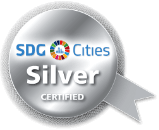November 14, 2022

 Cochabamba
CochabambaBolivia
856.2k
291 km2
2,558 m

November 14, 2022
Originally known as Villa de Oropeza, the city was later named Cochabamba, the Quechua name for the area, meaning “a plain full of small lakes.”
The pleasant climate and surroundings have contributed to making Cochabamba one of Bolivia's largest cities.
The area where Cochabamba is located is often called Bolivia's granary. The main produce include grains, potatoes, coffee, sugarcane, cacao, and fruit. [1]
The data track ensures that cities can access and use data to describe their baseline on SDG (Sustainable Development Goals) achievement and inform local action. City level statistical data, spatial data and perception data will be collected and analyzed to:
Participating cities will be provided with digital data tools in line with the Global Urban Monitoring Framework.
The strategic planning track ensures that city data merges with community and stakeholder participation to generate inclusive, spatially represented strategic plans for 2030. Participating cities will be provided with guidance based on an existing range of strategic planning tools.
Cities must identify priorities, complete a Voluntary Local Review, and develop a Strategic Development Plan.
In line with the new urban agenda, this track aims to ensure adequate local systems and institutional capacities in areas of governance; integrated urban and territorial planning and design; effective revenue and finance; and effective, equitable urban basic services. participating cities will be provided with digital diagnostic tools and training materials and will be connected in learning communities with cities with similar capacity development priorities.
This track supports the financing of high impact projects in cities through the Cities Investment Facility, comprising of:
Coming soon.